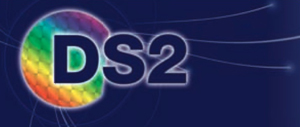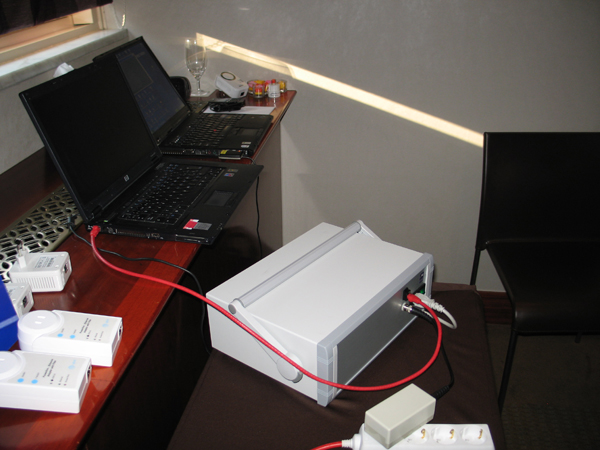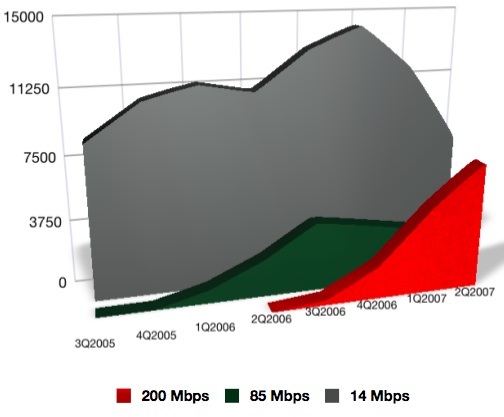
Yesterday, DS2, a leading provider of chipsets for powerline networking devices, hosted a demonstration of its next-generation equipment for the press and financial analysts. The hardware was impressive, handling data at sustained rates of well over 400Mbps while maintaining backwards compatibility with earlier generations of the company's hardware. But, while powerline networking is a promising solution for a number of problems, there are some substantial challenges to its adoption by the broader market.
Built for speed
DS2, based in Valencia, designs the processors and creates integrated chipsets that enable OEMs to produce networking solutions; they don't actually sell end-user hardware themselves. The previous generation DS2 chipset, introduced four years ago, enabled communications at 200Mbps over standard power lines. That generation has been widely deployed by European telcos, and displaces earlier equipment in consumer hardware.
The new generation doubles the bandwidth to 400Mbits a second. Even after control, error correction, and quality of service information are subtracted, the end users will have access to well over 200Mbps of usable bandwidth. That's double 100-BaseT Ethernet and better than 802.11n can do under most conditions. The demonstration hardware came in a carrying case that was roughly the size of an unabridged dictionary. It was shown handling data transfers at 230 Mbits/s between two laptops, happily sending its signal through surge protectors and power strips.

Hopefully, production units will be more compact than DS2's test equipment
DS2 has ensured that its hardware is backwards compatible with earlier products, and showed the new device talking to current consumer wallplug adapters at about 100Mbps. In contrast to wireless solutions, where the presence of earlier hardware pulls the entire network down to its level, each device on a powerline network negotiates its connections independently. Thus, a 400Mbps device can communicate at full speed with whatever generation hardware is present.
The presentation emphasized other advantages over wireless. 802.11 hardware constantly has to readjust its signal and contend with environments (such as New York City, where the demo took place) with many other wireless signals. As a result, data transfer using 802.11n was erratic; in contrast, the powerline transfer shot up to full speed and stayed there. DS2 also implied that differences in the underlying technology meant that powerline data transmission had fewer limitations for future bandwidth increases—they have a lead over wireless, and expected to keep it.
DS2's hardware will also come with some niceties on the software side. 256-bit AES encryption will be handled on the fly, and won't limit transmission speeds in any way. Pairing devices for encryption is vaguely similar to the process of pairing a phone with a Bluetooth headset. The chipset will also host a lightweight, POSIX-compliant operating system that will allow remote management; they demonstrated it hosting a web server that displayed performance data. Although the hardware is primarily being sold through its use of powerlines for data transmission, it will also work over coaxial cables and twisted-pair wiring, adding to the flexibility of its deployment.
Who needs the speed?
It's pretty easy to view 400Mbps as overkill, but the company's CEO, Jorge Blasco, did his best to argue otherwise. He pointed out that, four years ago when the 200Mbps hardware was introduced, everyone viewed that as excessive. Due to market realities, however, the 200Mbps equipment has only recently reached the point where it represented the majority of the powerline hardware sold. They want the hardware on the market as soon as possible, so that it's common and cheap by the time that bandwidth needs catch up. Besides, Blasco said, "speed is never high enough if you can deliver it at the right cost."

Planning for the adoption curve: NPD Group data shows that it takes some time for new equipment to displace earlier generations.
DS2 also has some pretty clear ideas of what will drive future bandwidth needs: delivery of HD content and IPTV. Chano Gomez, one of the company's VPs, expects HD movie downloads "very soon," and highlighted IPTV self-install kits offered by BT that include powerline hardware. According to DS2, the new hardware will allow IPTV providers to send 10 HD channels down the pipes simultaneously.
Gomez also suggested that 400Mbps hardware would be even more critical once content makes its way inside the home, as home networks are going to need roughly three times the bandwidth of their connection to the outside world. That's because of centralized storage devices, such as HD-DVRs and NAS boxes, that are going to need to be able to send HD streams to several locations in the house while simultaneously supporting computer backups and internet access. Suddenly, 400Mbps doesn't seem like overkill.
Remaining barriers
So, why aren't we all using powerline network equipment? In Europe, DS2 equipment is used by telcos serving a total of nearly 400 million customers, but they are very unevenly distributed: over half are customers of the Spanish company Telefonica. The presentation did not indicate how many of them relied directly on DS2 equipment, however. In the US, regulations can vary from state to state; in some cases, power companies are prohibited from using their wiring for anything other than the delivery of power. On the national level, the FCC already considers powerline broadband to be just another information service, so the states appear to be the big hold up.
For the home user, cost of equipment has been a major factor. 802.11 hardware is good enough for most common uses, and its volume of sales and bundling as standard hardware have caused prices of even the most current equipment to drop rapidly. A set of four powerline adapters, in contrast, can run well over $100. That situation is unlikely to change until bandwidth needs outpace 802.11's capacity. Performance has been disappointing as well. Some of the recent HomePlug AV powerline networking equipment we've tested at the Orbiting HQ has failed to impress, with speeds lagging 802.11g, let alone 802.11n.
Worse still for both consumers and ISPs are compatibility problems among the equipment from the three main providers—the DS2 execs were happy to point out that some of their competitors make equipment that's not even compatible with their own earlier generations, much less anyone else's. DS2 is trying to work with the IEEE to define a powerline standard, but the proposal currently under consideration would allow different "flavors" of the standard that remain incompatible. As things stand now, however, buying equipment from different companies can be a crapshoot.
reader comments